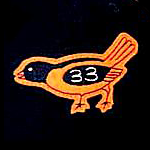
John Joseph Dunn was an American pitcher and infielder in Major League Baseball at the turn of the 20th century who later became a minor league baseball club owner.

The Federal League of Base Ball Clubs, known simply as the Federal League, was an American professional baseball league that played its first season as a minor league in 1913 and operated as a "third major league", in competition with the established National and American Leagues, from 1914 to 1915.

Oriole Park at Camden Yards, commonly known as Camden Yards, is a baseball stadium in Baltimore, Maryland. It is the home ballpark of Major League Baseball's Baltimore Orioles, and the first of the "retro" major league ballparks constructed during the 1990s and early 2000s. It was completed in 1992 to replace Memorial Stadium. The stadium is in downtown Baltimore, a few blocks west of the Inner Harbor in the Camden Yards Sports Complex.

The city of Baltimore, Maryland, has been home to two Minor League Baseball teams called the Baltimore Orioles, in addition to the three Major League Baseball teams that have used the name
The following are the baseball events of the year 1966 throughout the world.
The following are the baseball events of the year 1961 throughout the world.
The following are the baseball events of the year 1956 throughout the world.
The following are the baseball events of the year 1959 throughout the world.
The following are the baseball events of the year 1954 throughout the world.
The following are the baseball events of the year 1952 throughout the world.
The following are the baseball events of the year 1927 throughout the world.
The following are the baseball events of the year 1943 throughout the world.
The following are the baseball events of the year 1942 throughout the world.
The following are the baseball events of the year 1934 throughout the world.
The 1983 American League Championship Series was played between the Chicago White Sox and the Baltimore Orioles from October 5 to 8.
The 1992 Baltimore Orioles season was a season in American baseball. It involved the Orioles finishing third in the American League East with a record of 89 wins and 73 losses.
The 1954 Baltimore Orioles season saw the restoration of Major League Baseball to Baltimore after a 51-year absence, and the debut of the modern edition of the MLB Oriole franchise. Upon the transfer of the moribund St. Louis Browns on September 30, 1953, Baltimore returned to the American League over a half century after the Orioles of 1901–02 departed for New York City, where they eventually became the Yankees. The Baltimore Terrapins of the "outlaw" Federal League filled the void in 1914 and 1915, but the insurgent circuit collapsed without gaining recognition as a "third major league," and, as of 2022, its status remained in dispute. During most of its 51 seasons without a major-league team, Baltimore was represented in Organized Baseball by a top-level minor-league club, the Orioles of the International League.

Oriole Park was the name of multiple baseball parks in Baltimore, Maryland, all built within a few blocks of each other.

Oriole Park (V) is the name used by baseball historians to designate the longest-lasting of several former major league and minor league baseball parks in Baltimore, Maryland, each one named Oriole Park.







